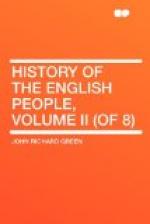[Sidenote: Scotch War]
The weight of the two Houses was seen in their settlement of the new government by the nomination of a Council with Earl Henry of Lancaster at its head. The Council had at once to meet fresh difficulties in the North. The truce so recently made ceased legally with Edward’s deposition; and the withdrawal of his royal title in further offers of peace warned Bruce of the new temper of the English rulers. Troops gathered on either side, and the English Council sought to pave the way for an attack by dividing Scotland against itself. Edward Balliol, a son of the former king John, was solemnly received as a vassal-king of Scotland at the English court. Robert was disabled by leprosy from taking the field in person, but the insult roused him to hurl his marauders again over the border under Douglas and Sir Thomas Randolph. The Scotch army has been painted for us by an eye-witness whose description is embodied in the work of Jehan le Bel. “It consisted of four thousand men-at-arms, knights, and esquires, well mounted, besides twenty thousand men bold and hardy, armed after the manner of their country, and mounted upon little hackneys that are never tied up or dressed, but turned immediately after the day’s march to pasture on the heath or in the fields.... They bring no carriages with them on account of the mountains they have to pass in Northumberland, neither do they carry with them any provisions of bread or wine, for their habits of sobriety are such in time of war that they will live for a long time on flesh half-sodden




